Sticky:
Extending Flight Times
Comments (0)
Add Comment
-
 Views: 408
Views: 408
Just one completely stock looking S105G here, except it isn't. Keep looking at the rest of the photos. -
 Views: 384
Views: 384
Nothing special from this angle. -
 Views: 460
Views: 460
Still can't see any difference from this angle. -
 Views: 445
Views: 445
But wait, if you look carefully, the canopy is separating from the frame. No tools required. Just pulled apart with your hands. -
 Views: 437
Views: 437
The key of the Quick Change canopy is a drilled out hole, and a small piece of laxen that holds the screw to the canopy. -
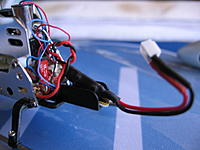 Views: 498
Views: 498
The stock battery is removed. The Overcharge Protection (OCP) circuitry is inside the black heat shrink, inline with a standard battery plug. -
 Views: 583
Views: 583
Now, I could use a bunch of these E-Flite style batteries. Shown here is an E-Flite 25C 150mAh 1S. I could charge these with my dedicated charger, or charge it through the S107G as stock, because the OCP is transplanted.
-
 Views: 437
Views: 437
Cobra smokey canopy and front spot light -
 Views: 381
Views: 381
Front view of the skinny fuselage -
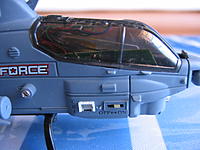 Views: 388
Views: 388
On/Off switch and charge port -
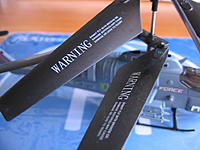 Views: 377
Views: 377
Blades, compatible with S107G -
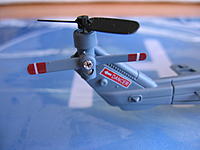 Views: 360
Views: 360
Typical 3 CH tail rotor, and the decorative tail rotor on the side -
 Views: 353
Views: 353
Missile Launchers. 0.84g a piece. Removable -
 Views: 375
Views: 375
Bottom side. IR Rx near the nose. The skids holds up the main inner shaft -
 Views: 563
Views: 563
Rx board inside the cockpit. The battery is taped onto the board
Sticky:
Ah, the Toilet Bowl Effect (TBE)
-
 Views: 992
Views: 992
A link sitting properly and squarely ON the ball. Also, flying with just one link, leaving the opposite side unconnected is perfectly okay. Sometimes, it is even preferred. -
 Views: 949
Views: 949
A link that is pushed past the ball and onto the arm. This will cause binding. -
 Views: 824
Views: 824
A loose enough link should hang down like this by gravity. -
 Views: 830
Views: 830
A tight link like this will surely cause binding issues -
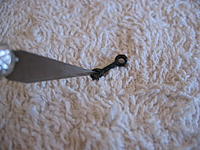 Views: 727
Views: 727
When links are just too tight, in addition to polishing and lubing, try cutting the O-ring open to release pressure. -
 Views: 673
Views: 673
Just cut along the red lines. The shape of the links will still hold on the ball as they are intend to. The pressure around the ball is greatly reduced and in many cases, TBE eliminated.
Sticky:
"My SYMA S107 has no lift…"
-
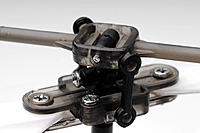 Views: 1885
Views: 1885
The two locking screws, one of each side of the shaft, are located just below the flybar and above the upper blades. -
 Views: 1509
Views: 1509
After removing the head assembly, a cut notch is visible about 2mm from the top of the inner shaft. Make sure one of the locking screws locks onto this notch, with the 2nd screw push in from behind. -
 Views: 1728
Views: 1728
Missing cogs in gear -
 Views: 2188
Views: 2188
Puffed or dying battery (Left) vs. Normal, healthy battery (Right)
-
 Views: 458
Views: 458
The balls are 12mm apart on the 9958 stick swash (left) and the shorts balls are 16mm apart on the v911 swash (right). -
 Views: 408
Views: 408
The long balls are 20mm apart!!! -
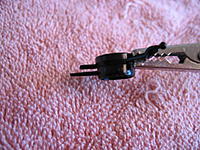 Views: 442
Views: 442
After clipping of a couple of arms, the v911 lower swash is glued to the bottom of the 9958 lower swash. -
 Views: 439
Views: 439
The v911 upper swash is mated. The new assembly is just 0.2 g heavier than stock. -
 Views: 445
Views: 445
This is the bottom side of the swash plate assembly. -
 Views: 595
Views: 595
Putting it all together. Notice the extreme angle of the links. The long guide pin from the v911 lower swash is sitting comfortable in the pin guide, while the stock pin is riding too high.
Sticky:
SYMA S107 Pivot Pins
-
 Views: 512
Views: 512
Fig. 1. The Inner Shaft and Rotor Head Assembly. Part Number S107-013. -
 Views: 432
Views: 432
Fig. 2. The Pivot Pin on the left is intact, while the one on the right is broken. -
 Views: 400
Views: 400
Fig. 3. Turn your S107 upside down for inspection. -
 Views: 513
Views: 513
Fig. 4. The pivot pin extends from the shaft into the upper blade holder. -
 Views: 429
Views: 429
Fig. 5. The upper blades must be able to tilt from side to side in this orientation, about the pivot pins. -
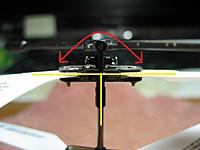 Views: 450
Views: 450
Fig. 6. But the upper blades must not be able to tilt in this orientation because the pivot pins are holding it perpendicular with the shaft.




